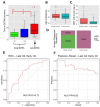Early-onset difficult-to-treat rheumatoid arthritis: proposal of data-driven predictors and temporal threshold
- PMID: 40684221
- PMCID: PMC12276655
- DOI: 10.1186/s13075-025-03621-9
Early-onset difficult-to-treat rheumatoid arthritis: proposal of data-driven predictors and temporal threshold
Abstract
Background: While risk factors for difficult-to-treat rheumatoid arthritis (D2TRA) have been studied in recent years, no studies have determined if there are differences between early and late developers of D2TRA. This study investigates whether patients can be classified by time to D2TRA development and examines risk factors for earlier onset.
Patients and methods: Observational study involving D2TRA patients whose reason for switching b/tsDMARD therapy was inefficacy (D2TRA-Inneficacy). Demographic data, comorbidities and disease characteristics, acute phase reactants and Disease Activity Score-28 [DAS28-ESR]) at baseline and 6 months after initiation of the first b/tsDMARD, and duration of each treatment were recorded. Using LASSO (Least Absolute Shrinkage and Selection Operator) Cox-regression feature-selection strategy, we identified those factors influencing the time to D2TRA-Inneficacy. DBSCAN clustering was conducted to identify subgroups based on time to D2TRA. Finally, we used ROC and Precision-Recall curves in tandem with the Youden index to establish a cutoff point for differentiating early and late-D2TRA.
Results: Of the 131 patients with D2TRA, 96 (72.7%) were classified as D2TRA-inefficacy. The variables presence of anxiety-depressive syndrome (ADS) at first b/tsDMARD, CRP at 6 months after starting the first b/tsDMARD and age at disease diagnosis were selected based on their contracted scores from the LASSO Cox-regression model, following the criterion of minimizing the cross-validated error. DBSCAN clustering based on selected variables identified three clusters. These clusters, differentiated by time to D2TRA, classified patients into early and late D2TRA groups. Finally, an optimal cut-off point of 44.5 months was determined using the Youden index to distinguish between the two groups.
Conclusion: In our cohort, the cut-off time for defining early developers of D2TRA-inefficacy was 44.5 months. The presence of ADS diagnosis, a higher CRP 6 months after the first b/tsDMARD, and being older at diagnosis were predictors of early development of D2TRA.
© 2025. The Author(s).
Conflict of interest statement
Declarations. Consent for publication: Not applicable. Competing interests: The authors declare no competing interests. Ethical approval: Study approval was obtained from the University Hospital La Paz Ethics Committee (PI-1155). All participants provided written informed consent.
Figures


References
-
- Takanashi S, Kaneko Y, Takeuchi T. Characteristics of patients with difficult-to-treat rheumatoid arthritis in clinical practice. Rheumatology. 2021;60(11):5247–56. - PubMed
-
- Novella-Navarro M, Ruiz-Esquide V, Torres-Ortiz G, Chacur CA, Tornero C, Fernández-Fernández E et al. A paradigm of difficult-to-treat rheumatoid arthritis: subtypes and early identification. Clin Exp Rheumatol [Internet]. 2022 May 19 [cited 2024 Jul 21]; Available from: https://www.clinexprheumatol.org/abstract.asp?a=18765 - PubMed
-
- Watanabe R, Hashimoto M, Murata K, Murakami K, Tanaka M, Ohmura K, et al. Prevalence and predictive factors of difficult-to-treat rheumatoid arthritis: the KURAMA cohort. Immunol Med. 2022;45(1):35–44. - PubMed
-
- Buch MH, Eyre S, McGonagle D. Persistent inflammatory and non-inflammatory mechanisms in refractory rheumatoid arthritis. Nat Rev Rheumatol. 2021;17(1):17–33. - PubMed
Publication types
MeSH terms
Substances
LinkOut - more resources
Full Text Sources
Medical
Research Materials
Miscellaneous

